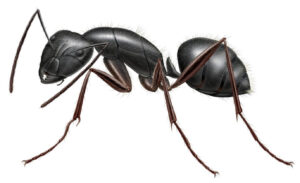 Characteristics: Moderately sized mature colonies contain more than 3,000 workers with one queen per colony (colonies may contain satellite nests that consist of workers, larvae, and pupae; together with the main colony, the total population may exceed 15,000).
Characteristics: Moderately sized mature colonies contain more than 3,000 workers with one queen per colony (colonies may contain satellite nests that consist of workers, larvae, and pupae; together with the main colony, the total population may exceed 15,000).
Nests usually originate in moist, decayed wood and voids and may later expand into sound wood. Look for coarse sawdust piles (frass) that contain insect body parts and listen for the sound produced as workers chew to remove wood to enlarge the nest.
Outside, nests are commonly found in dead or damaged portions of trees, rotting logs and stumps. Carpenter ants forage alone or along trails 300 or more feet from the nest. “Trunk trails” between parent and satellite nests are clear of vegetation and debris, typically cutting across lawns. Carpenter ants enter buildings around door and window frames, through eaves, along plumbing and utility lines, and over branches touching the structure. Peak foraging occurs at night.
Feeding Preferences: Carpenter ants feed primarily on insect honeydew, plant and fruit juices and insects. Indoors, they feed on food debris, including sweets, eggs, meats, cakes, pet foods and grease.
Control: Find and directly treat as many nests as possible. Dust are good flushing agents when inspecting voids. Check suspicious areas with a probe that will penetrate infested wood. Successful control depends on eliminating the parent colony, which is usually located outdoors.
- Thoroughly inspect property and interview residents to help locate nests and identify conducive conditions. Trim vegetation and eliminate moisture problems.
- For colonies in wall voids, inject an insecticide dust, or inject voids with a Foam insecticide.
- For effective perimeter treatments, apply a spot treatments to any possible ant entry point. Apply insecticide sprays around the base of trees that possibly harbor nests.
- Place ant bait stations on or around foraging trails, near suspected nest locations, where ants enter the building, in areas with water damage and on trunks of trees with ant activity.